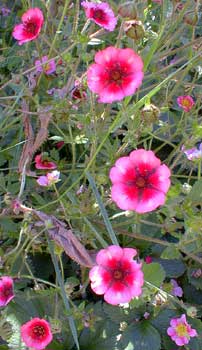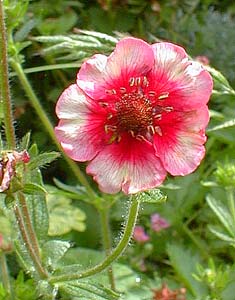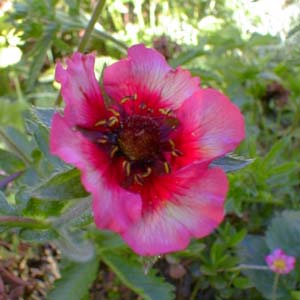
'Melton Fire'
Nepalese Five-Finger Potentilla
"I wish I knew the woods like you do. Say, what's the name of that little red flower?"
Rubbing his back, Joe regarded the flower resentfully "Well, some folks call it one thing & some calls it another. I always just call it Pink Flower."
-from"Babbitt"
by Lewis Sinclair
(1885-1951)
by Lewis Sinclair
(1885-1951)
 There used to be a charming & somewhat eccentric nursery near us that kept unpredictable hours, as the woman who owned it was a bit of an "old time hippy" whose laid back attitude about life taking precedence over labor. She sold wonderful "garden junk" such as salvaged iron off vintage machinery, grills off classic cars, dented antique washtubs or watering cans, never at all expensive.
There used to be a charming & somewhat eccentric nursery near us that kept unpredictable hours, as the woman who owned it was a bit of an "old time hippy" whose laid back attitude about life taking precedence over labor. She sold wonderful "garden junk" such as salvaged iron off vintage machinery, grills off classic cars, dented antique washtubs or watering cans, never at all expensive.The nursery is still there, but closed for some years, going to seed. I wish it were mine! It's an ideal location if someone would restore it & give it predictable hours.
The owner was very lax about labeling things, especially rapidly growing or self-seeding plants such as she divided or potted up herself to sell. She usually had a good memory for what's in every pot. However, in 2002 we bought something from her she struggled to recall what it was, & slowly lit upon "some kind of ornamental strawberry."
We brought a pot of it home & planted it at the edge of a patch of 'Pink Panda' ornamental strawberry. I did immediately wonder why the leaf arrangement was in sets of five like cinquefoil whereas the 'Pink Panda' was in sets of three. I even looked it up & thought the leaf looked like Potentilla nepalensis, except that throughout that first year in the garden, our little start remained a very flat-to-the-ground strawberry-like clump for which I had to keep the 'Pink Panda' from overwhelming it.
 Since Nepalese Potentilla flowers profusely on upright branches, & our small perennial bloomed only a little without any height at all, I just decided the seller probably knew what she had sold, & the reason it looked like a potentilla was because ornamental strawberries are in fact hybridized with potentillas.
Since Nepalese Potentilla flowers profusely on upright branches, & our small perennial bloomed only a little without any height at all, I just decided the seller probably knew what she had sold, & the reason it looked like a potentilla was because ornamental strawberries are in fact hybridized with potentillas.Although during that first spring, summer, & autumn it remained a very prostrate clump that did not spread much, in retrospect I realize it was just busy putting down its roots. Beginning the following spring, it started to reach outward & upward, until it was a substantial subshrub, & not the strawberry-like creeper it had seemed likely to be for its first year.
That second spring it really took off. That one little clump reached its slender limb structure three feet in all directions for a six-foot spread all told. It flowered moderately in spring, then in summer it was just loaded with bright red & pink & cream tricolored blossoms. The flowering panicals stood upward to twenty inches of height.
Now there was no room left to believe the seller knew what she had sold. This was most obviously P. nepalensis. The most often offered deep rose cultivars are 'Miss Willmott' & 'Ron McBeth,' which are somewhat more compact & a little shorter than ours.
Ours had gotten so large it seemed obviously a wilder strain. It most resembled 'Melton Fire,' perhaps having reverted slightly to more of a wild state losing any compact trait, large & loose & spreading. The central clump is only ten inches or a foot tall & wide, but the leafed flower stems rise to two feet in the air & wind far in al ldirections. Its flowers appear throughout a bed, winding its branching stems amidst shrubbery or tall perennials, & wherever it finds good light, raises its blooms upward to full sun.
Whenever it seems like it might be done flowering, the branching stems need only be clipped away from the central clump, & it begins to produce flowers anew. It'll bloom June to first frost of autumn, or later. It wants plenty of sun, poor to only moderately fertile soil, & perfect drainage, though hardy & adaptable in a wide range of conditions.